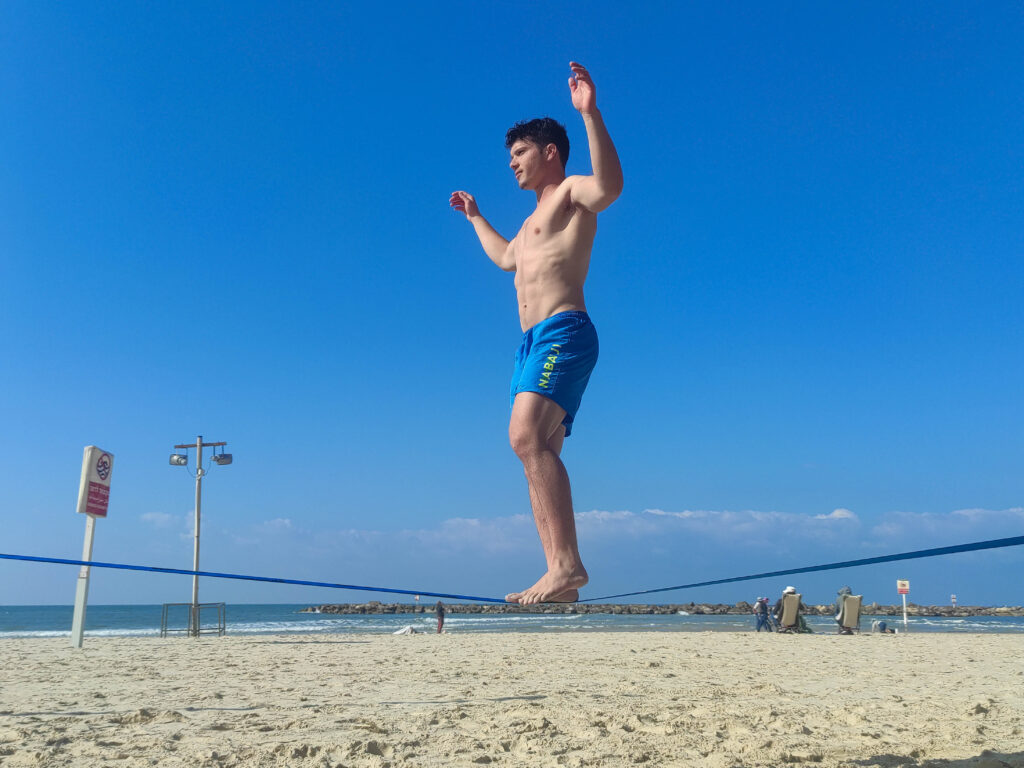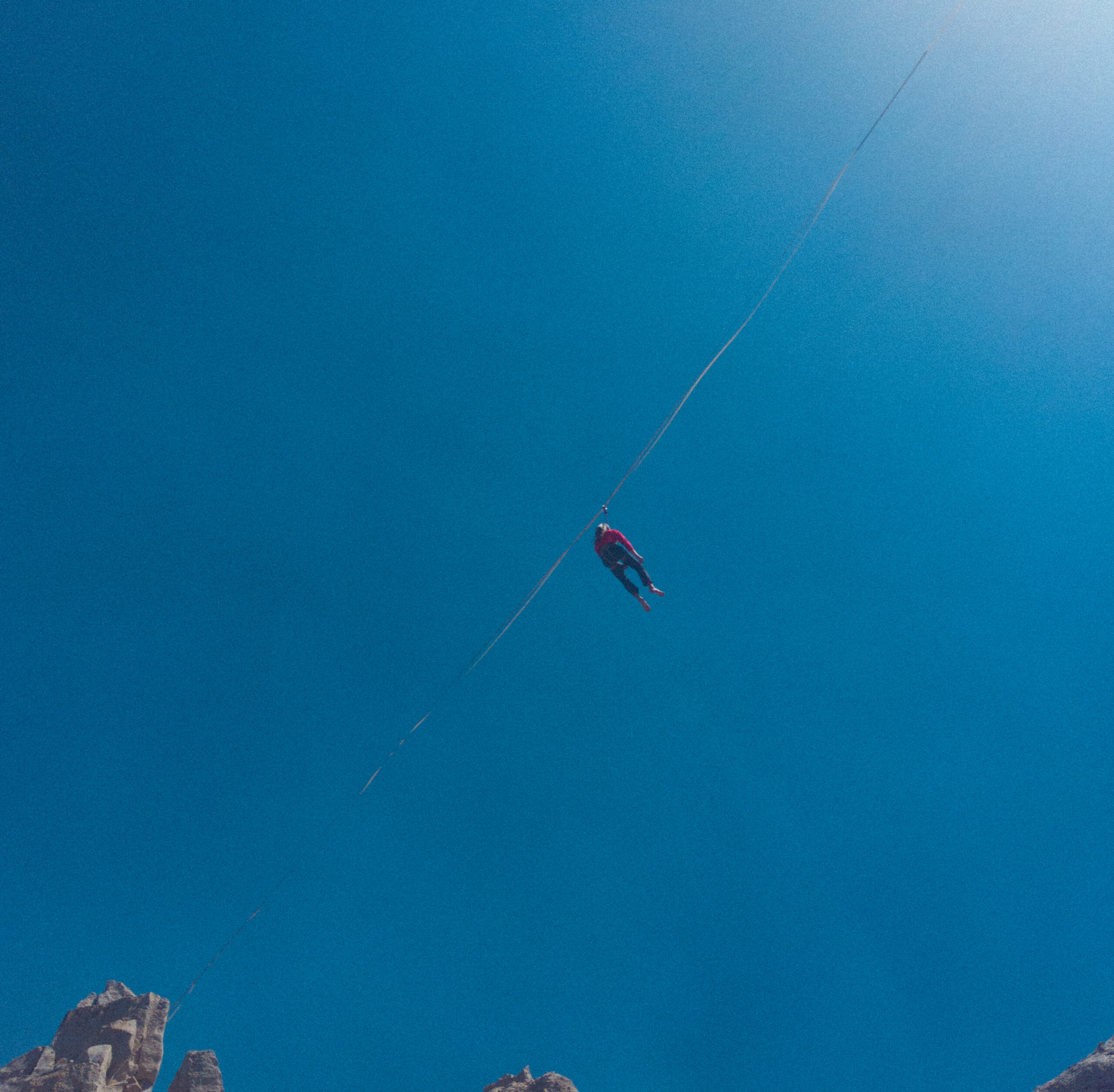Intro
I was introduced to the world of slacklining working at Yosemite National Park in summer 2022.
It was orientation day.
A 30 minute break from a truly fascinating HR presentation was all the time needed to race to the slacklines, running after my friends Lucia and Brian.
3 minutes later, we arrived where some slacklines were set up. They hopped on, and looked just like the floating butterflies Mohammed Ali talked about.
Sounds to me like he was a nature loving barefoot hippie.
I had no idea where to start, so they showed me how to sit and balance, offering tips like looking at and facing the end of the line, and using the arms to balance.
That was the start.
The same lines were set up 2 minutes from my job, so I spent many lunch breaks out there, away from the tourists and attempting to walk across. I went from unable to stand, to walking forwards and backwards on a 2 inch line.
Only took 3 months of semi-consistent sessions.
Along the journey I met a physicist named Chongo, and a Bobcat I call Alexander the Great. All in the sacred slacklining spot.
Fast forward to 2023. My homie Adam, fellow personal trainer and monstrously huge powerlifter, asked me what are the functional and training benefits of slacklining.
I replied with the standard concepts of balance, stability and lower body strength, but it felt like there was so much more.
A few days later I slacklined again, and thought more about the question.
Since then I better understand the reasons why slacklining is awesome for training and why I don’t see myself ever stopping.
This article is split up into 3 parts – The Body (Training), The Mind (Philosophy), and The Brain (Neuroscience).
You might be confused as to what Philosophy has to do with walking across thin webbing tied between a couple trees.
You see, it’s very simple.
It’s a Death Simulator.
Yes I know it sounds cool, and yes I thought of it all by myself…
Some call me a genius, others call me autistic, I’ll take either one.
But Death Simulator, Fear Machine, no matter the name you choose for it, it’s an amazing tool for conquering fears and embracing the inevitable ending waiting for us all.
The Body – Training
Slacklining in its basic form (No crazy tricks and flips), consists of a few basic movements.
Sitting, Standing, and Walking.
There are also transitions between these movements – standing up from sitting, and walking itself is just movement between standing.
Practicing and eventually mastering these movements develops transferable movements and skills to a wide variety of sports and activities.
Here’s how our body responds and reacts to the following movements.
Posture
If you have an asian mother, you’re very familiar with what posture is.
If you don’t have an asian mother, posture is the position in which you hold your body when standing or sitting.
In slacklining, good posture means your spine is straight, the top of your head is pulled towards the sky, plus your core and back muscles are activated to create stabilizing tension.
At first, having good posture will feel awkward and straining on the body, but as good training does, this becomes easier over time.
Posture is important because it improves the health of your nerves and blood vessels, is the center of support for all extending muscles, ligaments and tendons, and improves blood flow.
It can also resolve and prevent related back and neck pain (from improper posture).
Most importantly, good posture means your best friend’s asian mom will praise you for it.
Benefits Overview
- Stronger Core, Back and Neck Muscles
- Improved Blood flow
- Overall improved body health

Getting on the Line
Now that we have our posture set, it’s time to get on the line.
To stand on the line, place a bare foot parallel to the line, with the big toe and heel on the inner edge.
Push down and flex your foot, followed by your ankle, knees, and hips, all the while maintaining good posture and a strong core.
With enough strength or a bit of momentum (to help when first learning), you’re now standing upright with one leg on a 2 inch line suspended over nothing.
There’s only one absolute truth from this point on, and that is “What goes up, must come down”.
When falling, it’s always better to land on your feet.
If you’re on sand or have a pad underneath it’s not a big deal, but if you’re walking over hard ground, absorbing the impact properly with one leg is essential.
Of course, face planting and ass landings are always funny and sometimes we need a mouth full of Planet Earth.
The ideal way is to land on your feet and transfer the energy through your toes, ankle, knee and then hip (glutes).
With enough practice it becomes one fluid motion, and falling off in different directions is great for training high velocity, single leg landings.
Benefits Overview
- Complete lower body chain strength
- Feet, ankles, knees, hips
- Toes, small foot muscles, calves and tibia muscle, quads, hamstrings, all stabilizer muscles, glutes
- Slow and sudden movements (Standing and falling)
- Improve Coordination, Stability
- Ultimately prevents lower body injuries by consistently training single leg impacts in multiple directions and unexpected timing
Walking Across
Walking from one end of the line to the other can seem impossible.
However my perspective changed once someone told me it’s simply standing on one leg, then the other leg. Then repeat until you reach the end.
No shit huh.
But in practice it actually made it easier to get across, knowing my only task is to balance on one leg. When I feel stable, only then can I put my other foot in front, and take the back foot off.
The same principle applies to walking backwards, and I actually find backwards easier at times because you’re forced into feeling with your feet first and trusting them to support you.
Of course easier said than done, since there’s always wind pushing you to one side, sun in your eyes, and all the natural forces you can think of doing their best to make you fall.
Understand and accept that, then remember the basics.
Good posture, keep your lower body tight, and use your arms to balance in the way that feels most natural to you.
I tend to feel more stable when I put my mind into my feet and focus on balancing from that anchor (More on the brain – body connection in the neuroscience section)
Benefits Overview
- Continuous balance and stabilization from various positions, resistance levels, and spontaneous environmental forces
- Mind – Body connection
- Foot strength and stability
- Builds coordination – Walking backwards and forwards
Freestyle
Without a doubt, the slackline is designed for people to sit on, stand on, and walk across.
But there’s nothing better than misusing equipment, am I right?
Ways to “misuse” the slackline
- Pushups
- Planks (1 / 2 arms)
- Inverted row
- Pistol Squat
- Lunges
- Tricep Dips
- Sloth Walking across
To challenge yourself
- Loosen the slackline on any of the exercises
- Lower the height of the slackline for push ups, planks, and dips
- Raise the line for pistol squat, lunges and walking normal
The reason why these exercises are more difficult than their normal version, is because the slackline is an unstable surface. As a result you have to work even harder to keep yourself stable.
It’s a transferable principle. If you ever want to make and exercise harder and use your stabilizer muscles, either make yourself or your surface unstable. An example of each is planking with 1 arm vs 2, or instead planking on a yoga ball (or slackline).
The Mind – Philosophy
Stay tuned for part 2
The Brain – Neuroscience
A part 3 is coming soon!

